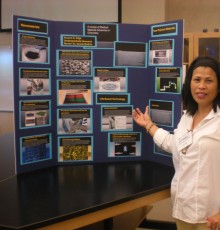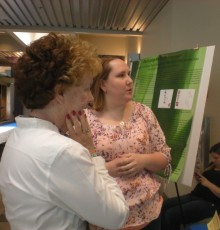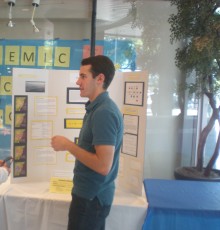Course-based Undergraduate Research Experience
- CURE: Chemical Analysis of Fabric Eco-Printing Process
-
CURE Project of General Chemistry II class Fall 2024 (Physical Science Department) in collaboration with Fine Arts Department, MCC.
This CURE Class conducted research to answer the question, will there be any remaining Iron (II) in wastewater after the process of eco-printing? MCC's Fine Arts Department does an eco-printing lab for fabric designing. Six student groups collected the data of six different tree leaves samples to determine how much Iron (II) would remain in the wastewater of the eco-printing process. For this determination, 2 experimental techniques were used. The titration technique was dichrometry using Diphenylamine (DPA) indicator and spectrophotometry technique used 1,10 -phenanthroline (Phen)complexation. Qualitative and quantitative data was collected. Effect of tap water and tannins was studied.
- CURE in Chemistry Lab
-
 The National Science Foundation funded STEM-CURE grant was deployed as the Cohort 3 CURE project in General Chemistry labs for two semesters. This was the very first exposure for the students to the unknown world of analysis. All the students in the lab section analyzed the soil samples collected from various regions of Arizona. Their CURE project was to determine the inorganic (IC) and organic carbon (OC) contents of these soils. The competency-based acid decomposition and Walkley-Black dichromate Redox reactions were the central idea in the analyses. Students were set up in teams and did pH measurements and multiple iterations of the IC and OC determinations of soil samples and further doing calculations on the collected data. Students understood the chemical principles in the procedures and the laboratory skills like working with strong chemicals, volumetry, massing, data collection, collaborative teamwork and poster presentation. Their CURE ended with an educative lecture in the relevant research area by a community partner visit.
The National Science Foundation funded STEM-CURE grant was deployed as the Cohort 3 CURE project in General Chemistry labs for two semesters. This was the very first exposure for the students to the unknown world of analysis. All the students in the lab section analyzed the soil samples collected from various regions of Arizona. Their CURE project was to determine the inorganic (IC) and organic carbon (OC) contents of these soils. The competency-based acid decomposition and Walkley-Black dichromate Redox reactions were the central idea in the analyses. Students were set up in teams and did pH measurements and multiple iterations of the IC and OC determinations of soil samples and further doing calculations on the collected data. Students understood the chemical principles in the procedures and the laboratory skills like working with strong chemicals, volumetry, massing, data collection, collaborative teamwork and poster presentation. Their CURE ended with an educative lecture in the relevant research area by a community partner visit.
Soil Environmental Chemistry
- Imran H. 'Comparative study of Organic carbon in indigenously created composts.' Fall 2022.
-
Plants grow in any soil in desert ecosystems like AZ. A comparative study of composts made from Meat scrapes vs. Vegetable scrapes and desert natural soil and store bought garden soil was studied by determining Total Organic Carbon Percentage. The Walkley-Black method using Ferrous Ammonium Sulfate -Potassium dichromate method was employed for the redox reaction. Back titration was carried out. Finding the amount of dichromate used, the carbon reacted was stoichiometrically calculated, and the organic carbon % for all the four types of soils was determined. Each of these composts were created by student from food scrapes, dried, weighed and further analyzed for % Organic C. It was realized that this could be an environmentally sustainable recycling of waste in the desert!
- Hiatt C. “A quicker method to estimate sulphates that came in soil from soap.” Spring 2022.
-
 The Impact of soaps and body washes released in soil was investigated. By doping soil with regular body wash solutions containing sulfates, the student established a method to quantitatively estimate its amount after and before growing plants in it. The plant's growth also spread light on qualitative aspects of the impact. Traditional method of sulphate estimation is cumbersome and time-consuming. Here the student tested out a faster EDTA titration method to estimate inorganic sulphate ions in soil extract. solution. The sulfate in 5 varying soil samples was extracted by Williams & Steinberg method using 0.15 % Calcium chloride solution. The sulfate in the sample was precipitated using Barium chloride solution and unreacted Ba2+ were estimated by back titration. Stoichiometry was employed to get % sulphate. The qualitative plant growth observations showed that plants thrive on soap and they can be fed with used soap water.
The Impact of soaps and body washes released in soil was investigated. By doping soil with regular body wash solutions containing sulfates, the student established a method to quantitatively estimate its amount after and before growing plants in it. The plant's growth also spread light on qualitative aspects of the impact. Traditional method of sulphate estimation is cumbersome and time-consuming. Here the student tested out a faster EDTA titration method to estimate inorganic sulphate ions in soil extract. solution. The sulfate in 5 varying soil samples was extracted by Williams & Steinberg method using 0.15 % Calcium chloride solution. The sulfate in the sample was precipitated using Barium chloride solution and unreacted Ba2+ were estimated by back titration. Stoichiometry was employed to get % sulphate. The qualitative plant growth observations showed that plants thrive on soap and they can be fed with used soap water. - Sarbo N. and Weigelt N. -- NASP (Native American Soil project Fall 2019-Spring 2020)
-
Joint venture of 3 MCC departments- Chemistry, Cultural Geography, Life Science with Native American student Association funded by AZ Lottery) These two students opted for Undergraduate research option of completing their General chemistry II coursework. They determined and studied pH, Total % Organic C and Available Phosphorus and compared the uncultivated and Cultivated samples of 12 different native Navajo nation soil samples.
- Horta B. – “Ion Selective Electrode Used for the Determination of Cadmium in Soil”. Spring 2016 ( Electrochemistry)
-
A semester long experiment at Mesa Community College was conducted to determine if wheatgrass could extract cadmium from infected soil. It was found that a soil sample digested in acid and diluted 100 times contained 22.68ppm cadmium before a wheatgrass plant was introduced and 1.05ppm Cd after the plant was left to grow for approximately two months. This resulted in a 95.37% decrease in cadmium concentration.
- Romero S. – “Exploring Complexometry as a Method for Determination of in Soil” Spring 2016
-
The efficacy of wheatgrass as a potential plant for phytoremediation of soil contaminated with Cd was tested in the lab with a series of complexometric titrations. Several procedures for extracting the Cd from the soil samples and measuring the obtained were attempted. Water, DTPA, 2.5% acetic acid, and 1 M nitric acid were considered as solvents to extract the Cd in order to measure its concentration in the contaminated soils (pre and post wheatgrass plant). Attempts to measure the Cd concentration in the resulting supernatants from those extracts by direct complexometric titration were explored, but consistent measurements were not obtained. Dissolving the soil sample in an aqua regia solution proved effective, and a complexometric back titration method using EDTA and for measuring the concentration in the soil was developed and successfully employed. The results from the experiment indicate that Cd was absorbed into the plant, but the experimental data from the titrations of blank Cd contaminated soil and post wheatgrass Cd contaminated soil did not vary. An experiment with an electrode done in conjunction with the complexometric back titrations indicate that the wheatgrass absorbed Cd from the soil. Thus, the amount of soil dissolved with aqua regia for testing purposes should be increased so that the difference in Cd concentration in both soils can be readily detected by complexometry.
- Thanh Nguyen – “Determination of Nitrates in plants using nitrate Ion Selective Electrode (ISE)” Spring 2014 ( Analytical Chemistry)
- Plant digestion and ISE determination method was established for Brassica rapa ( Mustard) plants grown in soil contaminated by indigenous dye waste. The ISE was standardized and calibrated and further used for analysis.
- Hilao Joanna- “Determination of nitrate content in different soil compositions” Fall 2013.( Soil environmental Chemistry)
- Study of indigenous dye lab waste disposal in soil medium for further phyto-extraction by plants was studied. Three different soil compositions were created in the lab and the growth of plants was observed in all the three soils types in controlled environment. The soil was then analyzed for nitrate content.
- Myers, Thomas –“Study of COD & TDS of a textile dye waste” Fall 12
-
In this laboratory based study, dye wastewater from the MCC Textile Department was added in differing concentrations to soil samples containing either Brassica rapa or Wheat Grass. The plants were grown in controlled green house atmosphere. The results lead to the conclusion that presence of dye wastewater did not kill the plants but instead lowered the COD and TDS values. This could possibly provide a ‘green’ method of this dye waste disposal at the same time beautifying the landscape.
- Russell ,Maurice--“Phytoextraction of Cd: A hope to clean up our soils” Can Wheat Grass be used to remove Cadmium from polluted soil? Fall 11.
-
Laboratory based study--Heavy metal Cadmium can cause health problems-- recognized as a carcinogen in humans Bio-accumulative in the environment Can easily get into the water and food source of an area. It was realized that Current methods of soil clean-up using chemical additions to soils can have a harsher ecological impact. Phytoextraction has a much smaller ecological impact, and is cheaper than current methods. Soil was spiked with 200mg of Cadmium per kg of soil. Shoots of plants were cut, dried and assayed for Cd content using Atomic Absorption Spectrophotometry (AAS).
- Huang, Yuchen,-- “Combined Ca and Mg determination in soil” Spr 10
-
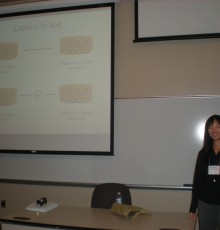 Cations in soil hold the negatively charged clay particles together. Calcium and Magnesium ions are essential nutrients for plant growth among all the common cations found in soil.
Cations in soil hold the negatively charged clay particles together. Calcium and Magnesium ions are essential nutrients for plant growth among all the common cations found in soil.In this study, we aimed to find out the concentration of the combination of both ions in soil on Mesa Community College campus. Samples of soil were taken at separate locations of the campus. Soil extraction methods including simple DI water extraction and ammonium acetate extraction; results were compared.
Disodium EDTA was used for titration, along with Eriochrome Black T as the indicator and pH 10 ammonium buffer stabilizing the reaction complex. The experiments were repeated and the results were found to be consistent.
Mentor: Dr. Asmita Kane Budruk, – Residential faculty in Chemistry-MCC Physical Sciences Department asmita.budruk@ mesacc.edu
- Reith, John -- " Spectrophotometric Determination of Cadmium in some sites at MCC." Spr-Fall 09
-
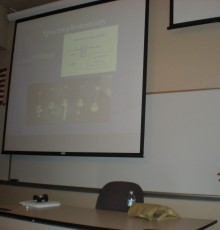 This study investigates the presence of heavy metal cadmium in soils at the Mesa Community Collage campus at Southern and Dobson in Mesa, Arizona.
This study investigates the presence of heavy metal cadmium in soils at the Mesa Community Collage campus at Southern and Dobson in Mesa, Arizona.Aspects of the investigation include the methodology of obtaining and handling of samples, the chemical process of determining cadmium level, as well as a discussion of the results.
The geographic method of obtaining samples was judgmental in that specific areas were targeted because of the land use.
Several samples were taken at each geographic site.
Samples were then combined for a composite sample. Each composite sample was then digested with acid. These digested samples were then combined with a chelate, 5,7-dibromo-8-hydroxyquinoline (DBHQ), to form a color complex for spectrophotometric analysis.
The referenced spectrophotometry with DBHQ method was chosen for its selectivity as well as its sensitivity to low levels of cadmium. This color complex was compared, utilizing spectrophotometry, to a standardized cadmium stock sample. The results revealed trends of varying amounts of cadmium levels at the different sites on campus. The absorption values were consistent for all the runs done.
- Huang, Yuchen----- "Do we have Lead in MCC soils?" Fall 09
-
 Lead is an important heavy metal. It’s also dangerous, especially to humans. In this research process, we aimed to find out about the concentration of lead (II) ions in the soil on MCC campus. Samples of soil were taken at selected locations where lead can possibly be found.
Lead is an important heavy metal. It’s also dangerous, especially to humans. In this research process, we aimed to find out about the concentration of lead (II) ions in the soil on MCC campus. Samples of soil were taken at selected locations where lead can possibly be found.Several samples were taken at each location. Since lead is present as lead (II) and lead (IV) ions in natural compounds, a masking method, using tartrate as the masking agent, was practiced to avoid the effect of lead (IV) ions have on the results.
Soil samples were digested with concentrated acids using a method from EPA; and a spectrophotometric method was selected to determine the concentration of lead (II) ions in the sample solutions.
The complex for spectrophotometry was formed by the neutralized sample solution along with 1,5-Diphenylthiocarbazone (dithizone), dilute aqueous hydrochloric acid, and CTAB. The experiments were repeated and the results were found to be consistent.
Analytical Chemistry
- Panza N. - "Study of various masking agents for indirect complexometry of heavy metal Cadmium" - Spring 2023
-
The indirect complexometric titration refers to masking an analyte of interest and then the reverse process of performing a direct titration also known as back titration. Such was performed in this project. The metal ions of interest was Cadmium as its Cd (II) ions. EDTA and lead (II) nitrate were used as the primary complexing agent and the titrant for back titration respectively. In this project, a variety of masking agents were deployed and tested for indirect complexometry in buffered solutions for the determination of cadmium(II) in standard solution, soil and cacao beans.
- Hardin A. –“ Report On The Testing of a Method For The Determination Of Vitamin B12 (Cyanocobalamin) In Bound Tablet Samples Using Nitroso-R-Salt (1-Nitroso-2-Napthol-3,6-Disulfonic Acid Disodium Salt)” Spring 2018
-
 Herein, the previously improvised method for the spectrophotometric determination of vitamin B12 (cyanocobalamin) in bound tablets using nitroso-r-salt (1-nitroso-2-napthol-3,6- disulfonic acid disodium salt) is tested for precision via the collection and analysis of a statistically valid number of trials. In all trials a standard deviation of 4.3% of the average, and a 95% confidence interval of ± 5.3% of the average(based on the Student's-t distribution for a sample size of 5). However, the expected average value was ~50 mcg of cyanocobalamin per tablet (based on manufacturer specifications). While the experimentally obtained average was 69 mcg cyanocobalamin per tablet. These results suggest that the method is fairly precise (S.D. <=5%)
Herein, the previously improvised method for the spectrophotometric determination of vitamin B12 (cyanocobalamin) in bound tablets using nitroso-r-salt (1-nitroso-2-napthol-3,6- disulfonic acid disodium salt) is tested for precision via the collection and analysis of a statistically valid number of trials. In all trials a standard deviation of 4.3% of the average, and a 95% confidence interval of ± 5.3% of the average(based on the Student's-t distribution for a sample size of 5). However, the expected average value was ~50 mcg of cyanocobalamin per tablet (based on manufacturer specifications). While the experimentally obtained average was 69 mcg cyanocobalamin per tablet. These results suggest that the method is fairly precise (S.D. <=5%) - Hardin A- “A Study of Complexometric Titrations of Cobalt in Vitamin B12 Using EDTA” Spring 2016
- Vitamin B12 is important for proper nervous system functioning, the formation of red blood cells and DNA synthesis. The vitamin has several forms, which are collectively referred to as Cobalamins, due to the fact that they contain Cobalt. This also gives B12 a naturally red color. Vitamin B12 is one of the essential nutrients not produced within the human body. Titrated B12 sample via existing direct titration methods for EDTA and Co2+ as outlined by Vogel. 3Improvised method with Heat (40°C), with No Hexamine, No Heat, with 0.0001M EDTA and with 0.001M EDTA. Collected data using these methods.
- Hardin A. “Report on the Spectrophotometric Determination of Vitamin B12 (Cyanocobalamin) Using NITROSO-R-SALT” Spring 2017
-
Vitamin B12 is a biologically important complex of cobalt. Herein, vitamin B12 is determined via the digestion of the organic component and the spectrophotometric determination of cobalt using Nitroso-R-Salt, a highly selective reagent, generally following and adapting the methods published by Ahmed, et al. Tests were carried out on a number of samples, including two energy drinks and a bound tablet supplement form. While the energy rinks yielded unusable results, the tablets (60 mcg B12) were detected as having 65±1 mcg B12 and 2.8 ±0.0 mcg Co each.
Environmental Sustainability
- Ryan M.,( Spring 2021) " Literary study of a publication on Iron-AQDS Redox Flow Battery"
-
In the scenario of energy deficit, electrochemical processes are promising to be future frontiers of energy storage and usage. Student investigated publication of Narayanan et al on Redox Flow batteries that work on Iron-AQDS oxidation-reduction reactions using polymer Nafion coated electrodes. The asymmetric and symmetric configuration were studied and energy cost was also investigated. This study has great potential as a sustainable energy resource.
- Youhana, Zain –“ Material advances in constructing environmentally green buildings” Spr 12
-
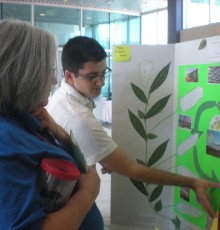 The Applied Research and Development building on the campus of Northern Arizona University is one of the greenest buildings in the world.
The Applied Research and Development building on the campus of Northern Arizona University is one of the greenest buildings in the world.In ARD building was built with by using recycled materials, sustainable materials, energy efficient heating, air, and electricity, a water retention basin for plumbing and a green roof to increase oxygen and to reduce carbon dioxide.
The building is rated 60 out of 69 on the Leadership Energy and Environment Design building rating system from the U.S. Green Building Council. Few other buildings in the world have earned at least 60 points.
- Russell, Maurice( Hons) – “A Review of Environmental Chemical Sustainability: Concerns of Some Consumer Electronic products.” Spr 10
-
A literature survey was done on chemical additives that are used in some electronic games.
The two additives that were focus of this study were Brominated Flame Retardants and Polyvinyl Chlorinated plastics.
Both these were found to be bio-accumulative in nature, and toxic to wildlife and humans.
Alternatives to replace both of these chemicals were researched, as well as ways to keep them from entering the environment are suggested.
Chemical Equilibria and Related Aspects
- Taylor, Michele,-- “An evolutionary review of Haber-Bosch Process for synthesis of Ammonia” (CHEMICAL EQUILIBRIUM) Spr 10
-
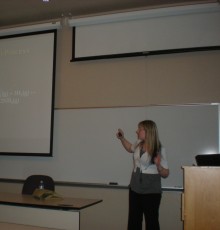 This paper reviews the process of creating ammonia from hydrogen and nitrogen as an amazing example of chemical equilibrium.
This paper reviews the process of creating ammonia from hydrogen and nitrogen as an amazing example of chemical equilibrium.It will show that in this reaction, the product yield is less than desirable and the reaction is very slow.
The Haber-Bosch process was established in 1918 by Fritz Haber and Carl Bosch for commercial production of ammonia. This paper also discusses the work done by Ertl in 2007 that throws light on the slow step of Haber-Bosch process reaction as studied by modern analytical techniques and improvisations suggested as a result of this research.
Mentor: Dr. Asmita Kane Budruk, – Residential faculty in Chemistry-MCC Physical Sciences Department asmita.budruk@ mesacc.edu
- Gentsch, Sandra( Hons) – “Study of Solubility Product Constant in Tooth Decay” Spr 12
-
 A study of solubility product constant as it relates to tooth decay yields a question of its ability to reveal the extent of enamel solubility.
A study of solubility product constant as it relates to tooth decay yields a question of its ability to reveal the extent of enamel solubility.I approached this question by comparing the different biological apatites that make up tooth enamel and their associated mineral ion concentrations. The research aims to compare the shift of equilibrium reactions of these crystals in the acidic solution of the saliva and the resulting process of tooth decay.
It is determined that the solubility product constant is an accurate measure of the solubility change of apatites of proportional molecular structure.
- Billings, Greg & Chandler, Megan—“ Buffer equilibrium in human blood” Spr 10
-
A study of acid base equilibria was done by taking into consideration the human blood as a buffer in the body.
A solution that functions to resist changes in the pH and ultimately maintain acid-base equilibrium as buffer. The human body is equipped with an array of complex mechanisms which play their part in order to avoid interrupting any of body’s normal functioning capacity. Bicarbonate and phosphate buffer systems were studied as examples to get greater depth of knowledge of this topic. Blood buffering of H+ ions occurs through the bicarbonate, phosphate, hemoglobin and blood proteins with bicarbonate being the chief role player. It was also researched that application of this buffering process is that it helps to maintain the acid- base equilibria in the blood which is extremely crucial during situations like those that induce a rapid accumulation of H+ ions during or after moderate ro intense exercise bouts.
Material Science Toward Sustainability
- Edge, Rosario--“A review of material advances in Chemistry” Spr 10
-
This report investigates the current state of radical material advances in chemistry and nanotechnology. It also examines the predicted future advancements of nanomaterials in the field of material chemistry, energy, and medical field.
The combination of electrical and mechanical properties is attracting a good deal of fundamental scientific interest for these materials. The report then focuses on making of these materials for a wide range of applications in electrostatic dissipation, electromagnetic shielding, batteries, electronic devices, compostable plastics, medical research, light emitting diodes, lasers, and solar cells. It is concluded that further technological material advances in chemistry as well as deployment of new nanotechnology techniques will continue to revolutionize the quality of communications, energy, medical and computing applications, transport, and manufacturing.
Study of Chemical Reactions
- Goins, Amanda( Hons)—“A Study of Chemical Reactions in Wastewater Treatment” Spr 12
-
Once treated, the waste water in Arizona is used in irrigation. Sustainability is a growing field and co0ncern today in the world. Waste water treatment plants play an important role in the cleaning of water for reuse. Chemical reactions is the large reason the water is released for irrigation or let back into the environment through rivers and such. A novel approach to study chemical reactions was by way of this real life example of chemical reactions in everyday life.
Studying chapter of “Chemical Reactions” in this manner helped understand classroom education in greater depth.
- HyunCheol Yun – “The study of Acid/Base Chemistry and ADVOS” Fall 2021. (Physical chemistry)
-
A publication on ‘clinical research conducted at a tertiary care ICU of the University Hospital of Technical University of Munich, Germany’ was critically studied. The publication had data regarding patients18 years or patients older with severe COVID-19 and pneumonia who were failing in the respiratory system. ADVOS (Advanced Organ Support) system is a latest multisystem of albumin hemodialysis that supports multiple organs by three circuits. Critical study of this article was done with respect to the acid base reactions occurring in the kidney, lung and liver functioning of human body. A comparative was presented on how ADVOS was advantageous in the light of the chemical buffering reactions in the respiratory and renal physiology.
Chemical Kinetics
- Clemmens , Zeke –“ Photochemical smog and chemical kinetics” Spr 12
-
Using the example of formation of Photochemical smog we can see a demonstration of how Chemical Kinetics work.
Chemical kinetics is a study of reaction rates, how reaction rates change under varying conditions, and what molecular events happen during the overall reaction. In the case of Photochemical smog, it is a chain of reactions (shown on right) leading to many hazardous chemicals. The hazardous products of the reactions would not be produced without certain concentrations or formations of molecules. With a better understanding of the kinetics we can see where we as a society can prevent this chain of reactions from beginning and have healthier air to breathe.
Activities
- Undergraduate Research Committee Past Chair and Undergraduate Research Mentor
-
Dr. Kane is mentoring Undergraduate Research in the Physical Science Department and helping to create a rich research environment at Mesa Community College.
Contact Dr. Asmita Kane
| Name | Title | Contact |
|---|---|---|
| Asmita Kane | Residential Faculty in Chemistry and Undergraduate Research Mentor | P: 480-461-7015 |






